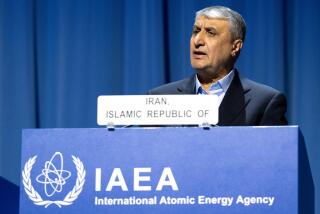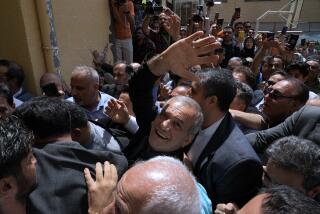Iran students carry on protests
- Share via
BEIRUT — Students in the western Iranian city of Ahvaz in recent days launched an impromptu protest in a campus auditorium. In Kashan on Monday, a group took over the campus cafeteria, singing anti-government songs. A couple of weeks ago in Tehran, others cheered wildly as someone threw a shoe at President Mahmoud Ahmadinejad’s former culture minister.
Then on Monday, students shouted down the ex-minister, Mohammad-Hossein Saffar-Harandi, once again.
Largely absent from international media reports and discounted by Western policymakers more focused on Iran’s nuclear program, the protest movement that erupted after Ahmadinejad’s disputed June 12 reelection has continued to smolder, mostly on college campuses.
Defying warnings by security officials, protesters plan to stage their first large public gatherings in six weeks on Wednesday. This time they plan to turn an annual nationwide march commemorating the 1979 takeover of the U.S. Embassy, held on the 13th day of the Persian calendar month of Aban, into an anti-government rally.
“The 13th of Aban is another appointment for us,” opposition leader Mir-Hossein Mousavi said in a statement published by reformist websites. “It is here to remind us, once again, that the people are the leaders.”
In the West, some analysts have begun to discount the opposition movement’s ability to affect Tehran’s decision-making. Some say months of repression have gutted the protest movement of its organizational capacity and leadership.
“Our view is that the regime has largely neutralized the opposition,” said Mark Fowler, a former CIA analyst who now heads Persia House, a service run by the Booz Allen Hamilton consulting firm in Washington. “It seems to us that they have pretty much decapitated the opposition in terms of leadership. I don’t think the government is particularly worried about it.”
Many also doubt the opposition’s ability to serve as an alternative to the hard-liners who have the upper hand in Tehran.
“Mousavi is not a liberal per se,” said Fowler. “When he was prime minister, he would have made the conservatives and the hard-liners proud.”
During a conference in Washington last month, Ataollah Mohajerani, a confidant of opposition figure Mehdi Karroubi, refused to distance himself from Ahmadinejad’s nuclear policies.
In a series of opinion pieces and public speeches, Flynt Leverett and Hillary Mann Leverett, who have served as Middle East analysts for the CIA, National Security Council and State Department, have urged the Obama administration to abide by the results of Iran’s election and to engage with Tehran’s current leadership.
Analysts say that dismissing Iran’s civil society as a factor in formulating Iran policy makes it much more palatable politically to either cut a deal with Ahmadinejad over the nuclear issue or up sanctions against Iran that could undermine the opposition.
Some U.S. foreign policy hawks “regard any ‘reform’ movement in Iran as a distraction from further sanctions and the outright U.S.-Iran hostility that they favor as a way of clarifying and simplifying U.S. policy choices in the region,” said Gary Sick, an Iran expert at Columbia University who served as a National Security Council official in the Carter administration.
According to several analysts, the U.S. government has yet to write off Iran’s so-called green movement, a diverse network of Iranian individuals and groups who oppose Ahmadinejad. Sick recalled that during the months of protests that led to the 1979 ouster of Iranian monarch Shah Mohammed Reza Pahlavi, there were also long stretches “when nothing seemed to be happening.”
But Iran’s nuclear program remains a top Washington priority. And few U.S. officials expect the opposition to cause any shift by the Iranian government on nuclear policy in the next year, a critical period in which many fear Tehran could move dramatically closer to gaining the capacity to build an atomic bomb.
The Obama administration “can’t hang its hat on the green movement,” said Karim Sadjadpour, an Iran expert at the Carnegie Endowment for International Peace who is in contact with both the State Department and White House Iran policy teams.
“But they don’t dismiss it,” he said. “They are aware that they need to consider the possibility of reconciling with Iran without pouring cold water on the momentum of the movement.”
The Iranian government itself has yet to write off the protest movement.
On Sept. 18, protesters infiltrated a rally in support of the Palestinian cause and transformed it into a massive demonstration that filled one of Tehran’s main thoroughfares, embarrassing the government.
Authorities have issued severe warnings of a crackdown against anyone who tries to turn the commemoration of the seizure of the U.S. Embassy into a protest rally.
State-controlled television warned viewers that “permission has been given to only one form of demonstration.”
“Death to Israel” and “Death to America” are the only officially sanctioned slogans.
--
More to Read
Sign up for Essential California
The most important California stories and recommendations in your inbox every morning.
You may occasionally receive promotional content from the Los Angeles Times.










